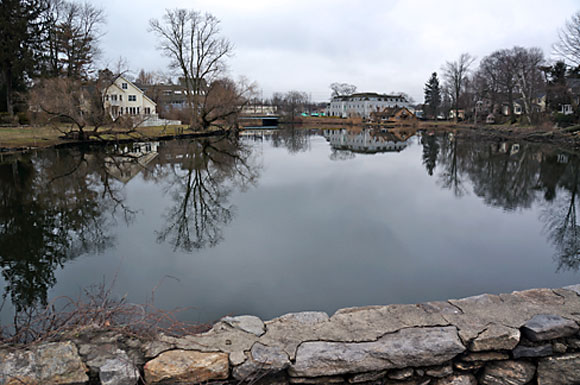Meetings on Exide plan come to Fairfield
Local discussions of a plan to remediate industrial wastes left behind by the former Exide battery plant next to the Mill River are scheduled to begin this week.
The draft plan calls for the lower Mill River to be dredged. The full plan can be downloaded from the Fairfield Conservation Department website, at http://www.fairfieldct.org/conscomiss.htm.
The Harbor Commission will review a draft Remediation Action Plan (SedRAP) Monday, July 8, at 4:30 p.m. in the second floor conference room at Sullivan Independence Hall. Public comment will be allowed.
The Shellfish Commission will perform its review Wednesday, July 10, at 7:30 p.m., also in the second floor conference room at Sullivan Independence Hall.
The Board of Selectmen will also discuss the plan at a date to be announced, and permits will be required for all work.
A hearing with the Department of Energy and Environmental Protection is also pending.
If the Town of Fairfield, the DEEP, Exide and Fair PLAN, a local environmental group, can come to agreement on the plan, the DEEP hearing will be closed and work will begin.
But if those parties cannot agree on how to proceed, the hearing will continue and a hearing officer will determine the course of action based on evidence presented.
Hearings were held in March. Details on the entire process can be found at http://www.ct.gov/deep/cwp/view.asp?a=2719&q=517076&deepNav_GID=1654.
Nutmeg TU members commented during earlier hearings on the proposal.
Fish and fishing would be affected during implementation of the plan.
Part of the deliberations center on increased sediment suspension and a greater disruption to flora and fauna if more material is removed.
“A significant socio-economic issue to consider in assessing overall benefits is the anticipated impact to recreational fishing and shellfish harvesting during and after remedial activities,” the draft reads. “The analysis concludes that risk to humans through consumption of fish/shellfish or ingestion of lead-contaminated sediment is substantially elevated in Area II, and elevated in Area I, with no substantial risks in Areas III, IV & V. The present risks must be weighed against the disturbance of these activities both during and after remediation. During remedial activities fishing/shellfish harvesting will not be physically possible in the immediate area of work and the destruction of substrates (i.e. submerged aquatic vegetation (SAV) and the benthic community) on which fish and shellfish are dependent may temporarily decrease fish and shellfish populations. According to Exponent, recovery of SAV and the benthic community from dredging activities is expected to take 1-3 years. These factors must be weighed against the overall remedial goal, which is complete removal of human risk from consuming lead-contaminated fish or shellfish.”
The long-term gains from removing lead, according to background in the plan, outweighs short-term disruptions.
Because a installation of a curtain that won’t restrict migration, dredging will not be allowed during the anadromous fish migration period in the Southport Harbor area, bounded by Harbor Road and a project limit line 225 feet south of Harbor Road.
Dredged material will be dried at the former Exide facility, 2190 Post Road, currently a vacant lot next to the Mill River, surrounded by a chain-link fence. That site will also be used for access and egress, staging of equipment and operations headquarters. The east bank of the Mill River, where work stopped during the 2005-09 Upland RAP, will need to be remediated and stabilized to allow the use of this area.
In preparation for the full project, the contractor would need to strip topsoil and install a layer of crushed stone. “The contractor may propose to install asphalt paving in lieu of crushed stone but will need to account for, through the use of engineered controls, any stormwater run-off that may results from this paving,” according to the draft plan.
Dredged material would be placed in Geotubes, “large bags made from a high tensile strength woven polypropylene fabric “geotextile” panels sewn to form long tubes for containment of pumped slurry,” according to the draft plan. The sediment will dry in those.
“In addition,” the plan continues, “two soil/sediment stockpile cells will be constructed using concrete barriers (construction block). Each concrete cell will have a capacity of no more than 250 cubic yards, surrounded by high-density sheeting to contain sediment.
The contractor will be required to “dredge, properly handle, transport and dispos of contaminated material (hazardous and non-hazardous), including characterizing the material, manifesting the loads, and obtaining approval from EPA-approved RCRA landfills and RCRA Out-of-State lined landfills,” according to the plan.
Fairfield’s sewer system cannot handle the volume of water discharged as the slurry is “dewatered,” according to the SedRAP, so filtrate will need to be discharged back into the Mill River.
Exide has applied to the DEEP to permit the discharge under a federal EPA program.
Bacteria sampling, if deemed necessary by DEEP and the Connecticut Department of Agriculture, will be conducted and evaluated by the agencies.
Exide has proposed construction of a “turbidity curtain,” or barrier, to contain sediment, with a corridor 15 feet wide and 2 feet deep to allow migration of fish from April through July.
